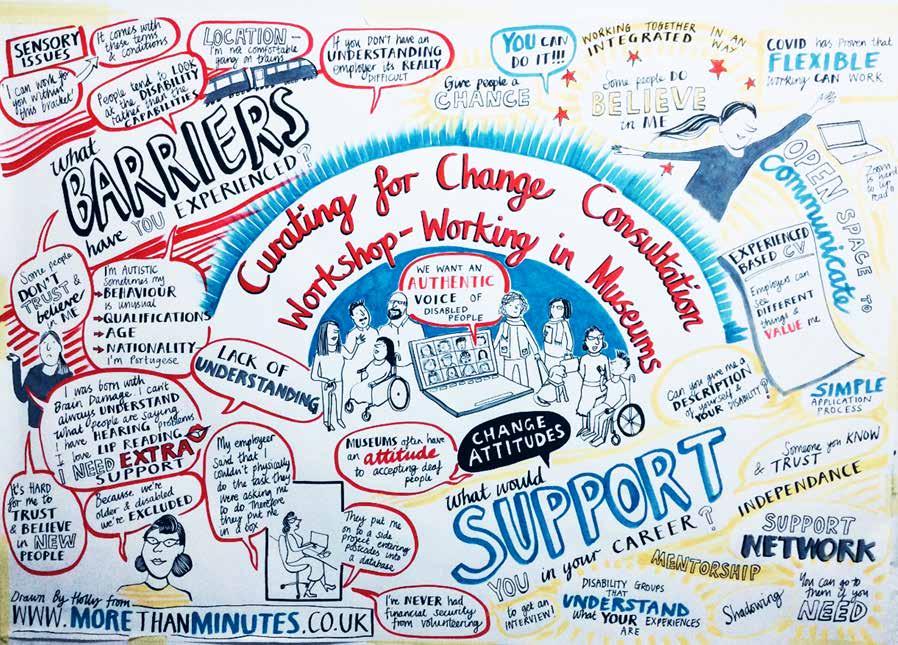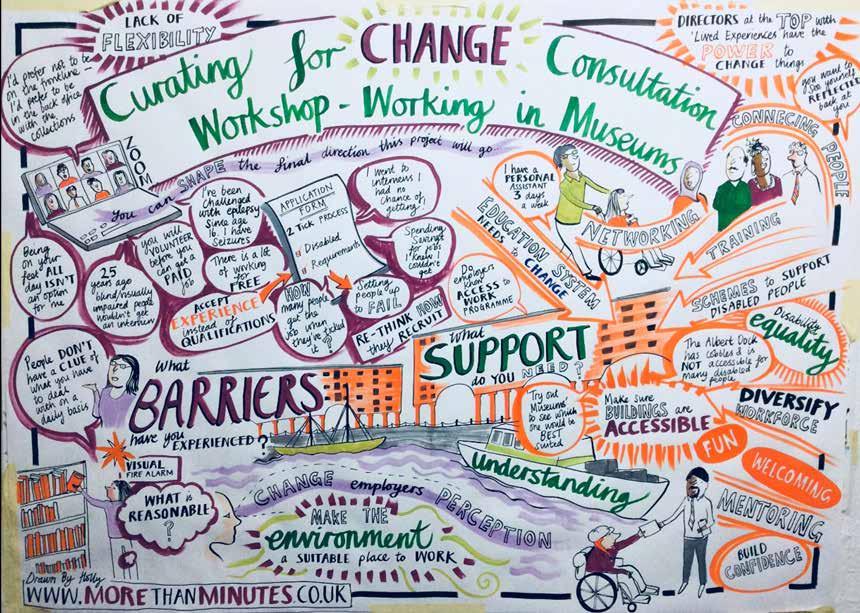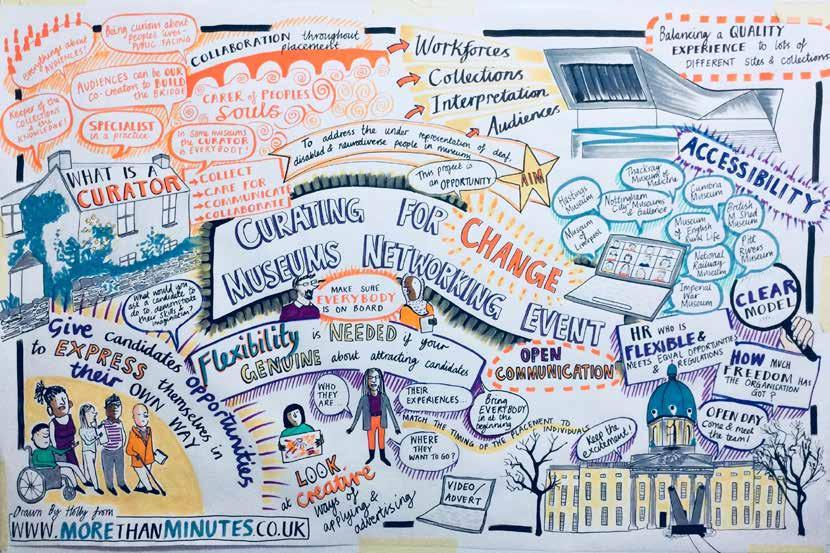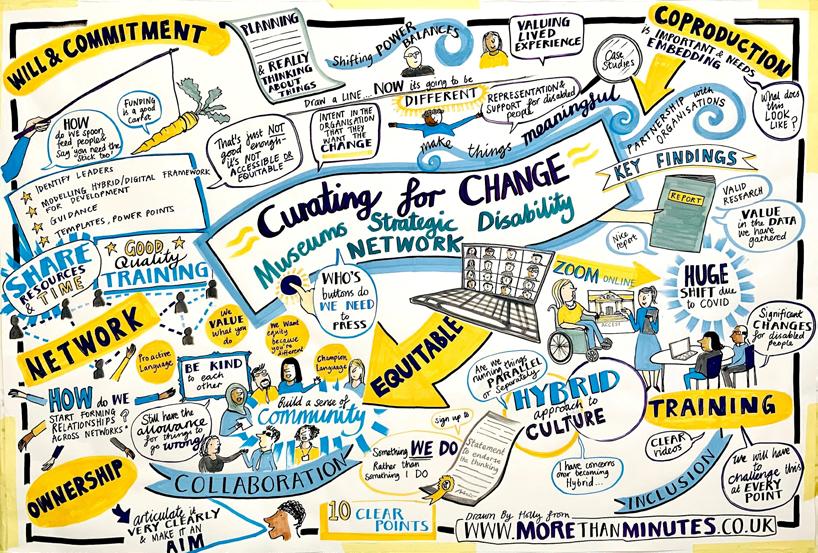
8 minute read
Section 3
Recruitment
Time and time again, recruitment practices were raised as one of the major barriers in preventing people from progressing or beginning their careers. Equally, our Partner Museums told us that they are keen to employ more D/deaf, disabled and neurodivergent people, yet struggle to attract and appoint applicants. Application packs often speak of employers wanting to increase diversity, or being a ‘Disability Confident’ employer. However, the D/deaf, disabled and neurodivergent people consulted see little evidence of this in recruitment processes, despite the fact that those changes having an impact are clear and, frequently, very simple.
Advertisement
3.1 Barriers to recruitment
Our consultation work identified a wide range of barriers facing D/deaf, disabled and neurodivergent people at every stage of the museum recruitment process. These include:
The requirement for qualifications
Many museum roles list specific qualifications, from undergraduate degrees to PhDs, as essential or desirable. However, D/deaf, disabled and neurodivergent people are less likely to hold these qualifications.
Though many job descriptions state that equivalent experience will be accepted as an alternative, this is hard to quantify and, as stated in the Fair Museum Jobs Manifesto [1], the regular listing of a qualification as the very first requirement suggests that these are still held as the ideal, discouraging candidates without qualifications from applying. Many recent and current vacancies list qualifications as a requirement, including one curator role for which a PhD is listed as essential. Though organisations may believe a degree is the best way to show skills in research, writing and communication, these skills could in fact easily be evidenced through previous experience. “Due to chronic illness (as well as financial issues), I am not able to apply for and complete a postgraduate degree in Archives, Library Studies, or Museum Studies. Applying for such a program has been my plan for several years, but due to worsening chronic illness and the ensuing need to put my health first, I have had to put those plans aside.”
survey respondent
[1] New Manifesto Explained: Qualifications
Update – Fair Museum Jobs
Left and below: Visual minutes from Consultation Workshops 1 & 2. Created by Holly Langley, More Than Minutes.

The requirement for significant paid or voluntary experience
Museum roles often require extensive experience for even entry level roles. At one large organisation, for example, a role that pays the Real Living Wage asks for previous experience in a paid trainee role, a position which in itself is highly competitive. With competition for paid roles being so high, volunteering is often the only way such experience may be gained. This is particularly challenging for D/deaf, disabled and neurodivergent people, for whom access issues, travel and finances can be insurmountable barriers to volunteering.
Below: Visual minutes from Consultation Workshop 3. Created by Holly Langley, More Than Minutes.
Physical requirements
Many entry level role specifications include requirements such as the ability to stand for hours at a time, lift objects, climb ladders or drive. Recent examples of role descriptions of entry level posts that are gateways to career development in large heritage organisations include the following requirements: } Essential: Excellent manual dexterity skills with a patient but efficient approach to completing tasks } Essential: Able to lift objects and work at height and in confined spaces } Desirable: Driving license } The role requires standing and/or working outdoors for long periods as is necessary.

This reflects a lack of flexibility and accommodation in opening up roles to D/deaf, disabled and neurodivergent people, as well as a lack of understanding of the support available via Access to Work. This is further compounded by some disabled people themselves being unaware of the support they are entitled to. Though these physical specifications become less important further up the career ladder, they are a particular barrier to those just beginning and unable to progress beyond this point.
Application format
Many employers ask applicants to complete time-consuming application forms, a format inaccessible to many D/deaf, disabled and neurodivergent people, preventing them from best demonstrating their experience and potential. Completing these forms can also be incredibly tiring, particularly when applicants are making multiple applications.
Below: Visual minutes from Partner Museums Network event. Created by Holly Langley, More Than Minutes.

workshop participant
Disability Confident scheme
The Disability Confident scheme, which encourages employers to recruit and retain disabled colleagues, on first glance appears to be a positive. The reality, as perceived by D/deaf, disabled and neurodivergent people, is very different. The application to be recognised as a Disability Confident employer requires very little action to improve accessibility and has minimal external regulation or verification. Though certain employers undoubtedly use the scheme to show their real commitment to change, the experience of those taking part in our workshops suggests many others display their badge with very little positive action to back it up, in the belief that holding the badge fulfils their accessibility obligations.

Disability Confident employers commit to interviewing disabled candidates who meet the role criteria. Those individuals we consulted who had been invited to interview under these circumstances felt they had been invited as part of a box-ticking exercise and were never seriously considered for the roles, wasting their time, energy and often travel expenses. Our consultation suggested that D/deaf, disabled and neurodivergent people are very aware that the Disability Confident scheme is not always a sign of an inclusive employer. Several of those consulted suggested they actively avoid making applications to Disability Confident organisations at all.
A lack of information on the role and organisation
Participants in our consultation workshops noted that they appreciate being given information about the practical elements of the role (e.g. working hours, workspace, etc.), the organisation and its working culture in the recruitment materials, allowing them to understand whether the position is a good fit for them before they go through the lengthy process of making an application.
Left and below: Visual minutes from Museums Strategic Disability Network Meetings in December 2020 and April 2021. Created by Holly Langley, More Than Minutes.

Interviews
The vast majority of museum interviews follow a standard format, with interviewees asked to answer questions not provided in advance, and deliver a presentation prepared before or during the interview. This lack of flexibility in format does not accommodate for variety in communication styles, or allow for those who require additional thinking time to recall information and formulate responses to questions. Until the advent of Covid-19, many employers insisted on in-person interviews, adding an additional barrier; the degree to which remote interviewing is an entirely acceptable alternative has now been made evident.
“In terms of the actual job interviews, definitely, I have struggled as an autistic person… I end up being treated as if I am stupid or I do not understand anything. They then assume that I am not going to be good at the work… We do not all communicate the same. We are not all going to communicate the same in the job. That doesn’t mean that we are not doing the job well.”
workshop participant
Expectation to fit a certain mould
Our consultation suggests that many D/deaf, disabled and neurodivergent interviewees feel they are expected to fit a certain museum worker ‘mould’, or that they don’t secure roles because they do not look, speak or act like other members of the team. Rather than welcome diversity and a range of voices, thereby contributing to a more resilient and creative organisation, many museums are inclined to appoint candidates in their own image. Fair Museum Jobs [2] have highlighted that this can be exacerbated when person specifications list personality traits (e.g. ‘outgoing’) rather than skills (‘experience working with a wide range of people’).
Inappropriate questioning
Our consultation with D/deaf, disabled and neurodivergent people highlighted the frequency with which unacceptable questions about a person’s impairments and the impact on their ability to do the job are asked, whether in the application or interview process. Recent examples include an application form where applicants were asked to give details about any periods of sickness absence.
[2] New Fair Museum Jobs Manifesto Explained
– Fair Museum Jobs
3.2 Recruitment review of our Partner Museums
Through their participation in Curating for Change, our Partner Museums have demonstrated that they are committed to recruiting more D/deaf, disabled and neurodivergent staff. When asked what they hoped to gain from taking part in Curating for Change, 94.1% stated that increasing their understanding of how to do this was one of the major reasons for taking part in the project. Our survey of museum partners asked ‘What are the barriers to employing more D/deaf, disabled and neurodivergent staff members?’ Some reported ‘a lack of space 35.3% and/or facilities’ as a challenge.
Many more highlighted issues around knowledge and confidence, including:
‘a lack of specialist contacts’ 64.7%
‘a lack of understanding and/or skills 64.7% to provide support’
‘a lack of confidence within our organisation’. 58.8% A lack of awareness of the issues facing D/deaf, disabled and neurodivergent people during the recruitment process was highlighted when findings of our consultation were shared with the museums themselves. Many expressed shock at the testimonies, redoubling their commitment to making changes, while beginning to think creatively about how things might be done differently.
“This was from an arts organisation and it says ‘Do you consider yourself to have a disability or health condition?’ Then you tick ‘Yes, no, or prefer not to say.’ Then it said ‘What is the effect or impact of your disability or health condition on your ability to give your best at work?’ Basically, they are writing it within their form that if you are disabled you will not be able to do the same job as somebody else.”



